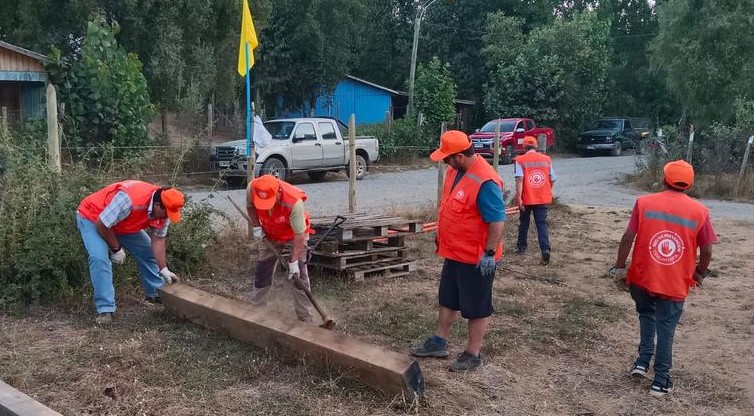Highlighting the Contribution of Forest Product Gatherers
It is estimated that there are over 37,000 gatherers of non-timber forest products (NTFPs) in Ñuble and Biobío, who work in forests collecting wild fruits, mushrooms, medicinal plants, seeds, and spices, as their ancestors did. These products constitute foods with significant nutritional and health benefits.
In this way, gatherers promote conscious and healthy eating in their communities and market their products by following a direct-to-consumer approach. This was one of the conclusions of the workshop "Recognizing the Contribution of Gatherers and Non-Timber Forest Products (NTFPs) to Food Sovereignty," organized by the Department of Agroindustry of the UdeC Faculty of Agricultural Engineering, as part of the Ñuble-Biobío Public-Private NTFP Coordination Table, with support from the "Productive Development and Territorial Promotion Program of the Nevados de Chillán-Laguna del Laja Biosphere Reserve in the Ñuble Region."
"The commitment of gatherers to biodiversity and natural resource conservation was acknowledged, as well as their contribution to food sovereignty through chemical-free production practices, responsible resource use, the supply of healthy foods, and short marketing circuits," summarized Pamela González Fuentes, project engineer at UdeC Agricultural Engineering and coordinator of the event.
The workshop, held at the UdeC Chillán campus, was attended by 35 gatherers from Ñuble, Biobío, Maule, and O’Higgins, including representatives from the Biobío, Ñuble, and Maule NTFP Gatherers' Association A.G., as well as from communities within the Biosphere Reserve in the municipalities of Coihueco, San Fabián, and Pinto.
According to the professional, the goal was to reflect on the contribution of gathering and gatherers to food sovereignty, but also to gather information on development gaps, challenges, and opportunities in this sector. "The idea is to continue working on this information with public and private entities," she stated.
Gatherers
Susana Romero, a gatherer from the Sepultura area in San Javier, Maule Region, acknowledged that this is an important activity for families, not only because of the seasonal income they earn from selling products, whether fresh or dried, but also because it is part of rural communities' culture, with practices passed down through generations. "Additionally, we feel like part of the forest—in a way, we are its caretakers. This activity supports us in various ways as women," she said.
Romero, a member of the peasant cooperative Despertar Hierba Luna, emphasized that "good practices are essential because only through rational exploitation can we ensure these products remain available in the future—harvesting a specific herb without overexploiting, without being predators."
Strengthening
Meanwhile, the Dean of UdeC Agricultural Engineering, Dr. María Eugenia González, highlighted the 15-year work of the Coordination Table, which includes, in addition to the coordinator, forestry companies, the NGO Taller de Acción Cultural, Infor, Indap, and the Ministry of Agriculture.
She also emphasized the research and support provided by the Faculty to gatherers through various initiatives, enabling training, advisory services, and value addition to NTFPs by developing innovative products such as rosehip lozenges or edible mushroom snacks. She also mentioned that results from boldo-based products are expected soon under the Biosphere Reserve promotion program.
Dr. González noted that the workshop's conclusions are valuable input for public entities' decision-making "to strengthen the sector and its people; gatherers are all part of peasant family farming, which is why we want to give it strong momentum." In this regard, she stressed the need for a government-level strengthening strategy through dialogue among stakeholders.
"We must encourage integration and interaction between public and private sectors because there is strong interest from public entities like Indap, the Regional Ministerial Secretariat of Agriculture, and Prodesal, as well as forestry companies. Therefore, continuous linkage efforts are needed," the Dean reflected.
Conclusions
Among the workshop's key conclusions, Pamela González highlighted that "the fundamental role of gatherers is expressed through various practices. First, sustainable gathering ensures only what is fair and necessary is extracted, unlike opportunistic predators. This gathering is based on their knowledge of the forest, its products, how to obtain them, and their uses. Additionally, they propagate plants adapted to their area and conserve native species."
She also emphasized a shared vision that "different stakeholders, particularly private companies, must work together with communities to ensure proposed support alternatives align with local needs and that information and resources reach gatherers in a timely manner."
Regarding key challenges, the following were mentioned: marketing, the lack of voluntary associative projects, raising awareness about healthy eating from these products, insufficient government support and recognition, and the loss of native wild products and water resources.
Source:ladiscusion.cl

















